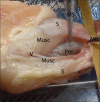Using of the Chicken Wing's Bone in the Microneusurgical Training Model for Microdrilling
- PMID: 30459854
- PMCID: PMC6208255
- DOI: 10.4103/ajns.AJNS_372_16
Using of the Chicken Wing's Bone in the Microneusurgical Training Model for Microdrilling
Abstract
Background and objective: Repetitive practicing of microneurosurgical techniques in experimental laboratory using real surgical instruments on training models is extremely important before starting the real surgical interventions. The modeling of the surgical steps with creating of suitable laboratory models is also another important issue in the successfully gaining of microneurosurgical practice.
Materials and methods: In this experimental study, it was created a laboratory training model for microneurosurgical drilling of cranial bones including the close location with the neural and vascular structures. All steps of this study were performed under the operating microscope. Twenty-five fresh chicken wings obtained from supermarket were used for this study. The difficulty and suitability of the model was evaluated in terms of the usability in the training of microneruosurgical microdrilling. Difficulty of the procedure was divided as three degree (very easy, easy, and difficult). The objective criterion for the evaluation of the difficulty of the procedure was the protection of the neurovascular and muscular structures during the procedure.
Results: The suitability of the procedure was also evaluated within three groups as bad, good, and perfect. In four (16%) chicken wing's bone, the difficulty of the microdirilling was evaluated as difficult. Fifteen (60%) of the chicken wing's bones were microsurgically drilled with easy procedure. The remaining six (24%) of the wing's bone microdrilling was evaluated as very easy procedure. The suitability of the model was evaluated as bad in three (12%) of the chicken wing's bone. The suitability was found as good in 16 (64%) of the bones. In the remaining three (24%) of the chicken wing's bone microdrilling, the suitability of the model was evaluated as perfect.
Conclusion: Microsurgical drilling of the chicken wing's bone without any vascular and muscular injury is accepted as the indication of the successfully surgical microdrilling process. Consolidation of the surgical practice in a laboratory setting, grasping and using of microsurgical instruments, can be repeated in several times in this model. We believe that this model will contribute to the practical training of microneurosurgery.
Keywords: Chicken wing's bone; microdrilling; microneurosurgery; training of microsurgery.
Conflict of interest statement
There are no conflicts of interest.
Figures






References
-
- Cokluk C, Aydin K. Maintaining microneurosurgical ability via staying active in microneurosurgery. Minim Invasive Neurosurg. 2007;50:324–7. - PubMed
-
- Sai Kiran NA, Furtado SV, Hegde AS. How I do it: Anterior clinoidectomy and optic canal unroofing for microneurosurgical management of ophthalmic segment aneurysms. Acta Neurochir (Wien) 2013;155:1025–9. - PubMed
-
- Yadav YR, Parihar V, Ratre S, Kher Y, Iqbal M. Microneurosurgical skills training. J Neurol Surg A Cent Eur Neurosurg. 2016;77:146–54. - PubMed
-
- Belykh E, Byvaltsev V. Off-the-job microsurgical training on dry models: Siberian experience. World Neurosurg. 2014;82:20–4. - PubMed
LinkOut - more resources
Full Text Sources
Research Materials

